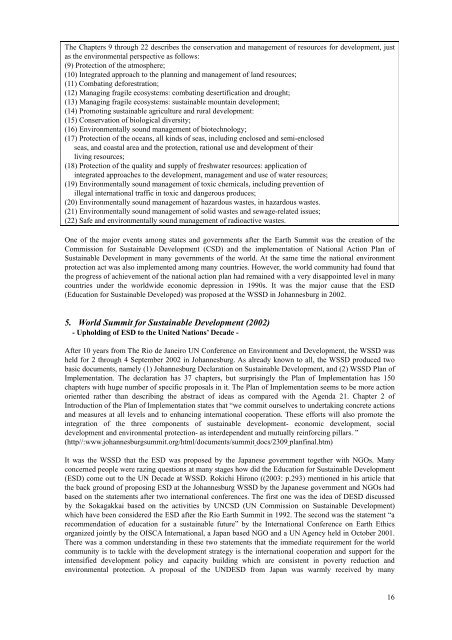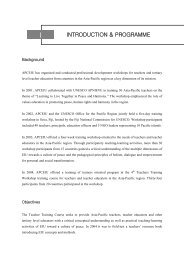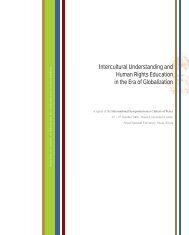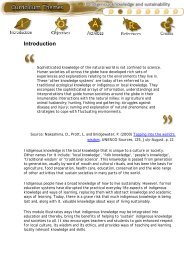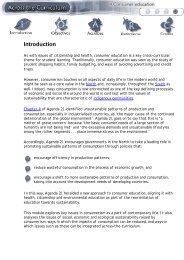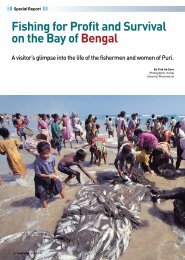REPORT OF UNESCO EXPERT MEETING ON - APCEIU
REPORT OF UNESCO EXPERT MEETING ON - APCEIU
REPORT OF UNESCO EXPERT MEETING ON - APCEIU
You also want an ePaper? Increase the reach of your titles
YUMPU automatically turns print PDFs into web optimized ePapers that Google loves.
The Chapters 9 through 22 describes the conservation and management of resources for development, just<br />
as the environmental perspective as follows:<br />
(9) Protection of the atmosphere;<br />
(10) Integrated approach to the planning and management of land resources;<br />
(11) Combating deforestration;<br />
(12) Managing fragile ecosystems: combating desertification and drought;<br />
(13) Managing fragile ecosystems: sustainable mountain development;<br />
(14) Promoting sustainable agriculture and rural development:<br />
(15) Conservation of biological diversity;<br />
(16) Environmentally sound management of biotechnology;<br />
(17) Protection of the oceans, all kinds of seas, including enclosed and semi-enclosed<br />
seas, and coastal area and the protection, rational use and development of their<br />
living resources;<br />
(18) Protection of the quality and supply of freshwater resources: application of<br />
integrated approaches to the development, management and use of water resources;<br />
(19) Environmentally sound management of toxic chemicals, including prevention of<br />
illegal international traffic in toxic and dangerous produces;<br />
(20) Environmentally sound management of hazardous wastes, in hazardous wastes.<br />
(21) Environmentally sound management of solid wastes and sewage-related issues;<br />
(22) Safe and environmentally sound management of radioactive wastes.<br />
One of the major events among states and governments after the Earth Summit was the creation of the<br />
Commission for Sustainable Development (CSD) and the implementation of National Action Plan of<br />
Sustainable Development in many governments of the world. At the same time the national environment<br />
protection act was also implemented among many countries. However, the world community had found that<br />
the progress of achievement of the national action plan had remained with a very disappointed level in many<br />
countries under the worldwide economic depression in 1990s. It was the major cause that the ESD<br />
(Education for Sustainable Developed) was proposed at the WSSD in Johannesburg in 2002.<br />
5. World Summit for Sustainable Development (2002)<br />
- Upholding of ESD to the United Nations’ Decade -<br />
After 10 years from The Rio de Janeiro UN Conference on Environment and Development, the WSSD was<br />
held for 2 through 4 September 2002 in Johannesburg. As already known to all, the WSSD produced two<br />
basic documents, namely (1) Johannesburg Declaration on Sustainable Development, and (2) WSSD Plan of<br />
Implementation. The declaration has 37 chapters, but surprisingly the Plan of Implementation has 150<br />
chapters with huge number of specific proposals in it. The Plan of Implementation seems to be more action<br />
oriented rather than describing the abstract of ideas as compared with the Agenda 21. Chapter 2 of<br />
Introduction of the Plan of Implementation states that “we commit ourselves to undertaking concrete actions<br />
and measures at all levels and to enhancing international cooperation. These efforts will also promote the<br />
integration of the three components of sustainable development- economic development, social<br />
development and environmental protection- as interdependent and mutually reinforcing pillars. ”<br />
(http//:www.johannesburgsummit.org/html/documents/summit docs/2309 planfinal.htm)<br />
It was the WSSD that the ESD was proposed by the Japanese government together with NGOs. Many<br />
concerned people were razing questions at many stages how did the Education for Sustainable Development<br />
(ESD) come out to the UN Decade at WSSD. Rokichi Hirono ((2003: p.293) mentioned in his article that<br />
the back ground of proposing ESD at the Johannesburg WSSD by the Japanese government and NGOs had<br />
based on the statements after two international conferences. The first one was the idea of DESD discussed<br />
by the Sokagakkai based on the activities by UNCSD (UN Commission on Sustainable Development)<br />
which have been considered the ESD after the Rio Earth Summit in 1992. The second was the statement “a<br />
recommendation of education for a sustainable future” by the International Conference on Earth Ethics<br />
organized jointly by the OISCA International, a Japan based NGO and a UN Agency held in October 2001.<br />
There was a common understanding in these two statements that the immediate requirement for the world<br />
community is to tackle with the development strategy is the international cooperation and support for the<br />
intensified development policy and capacity building which are consistent in poverty reduction and<br />
environmental protection. A proposal of the UNDESD from Japan was warmly received by many<br />
16


